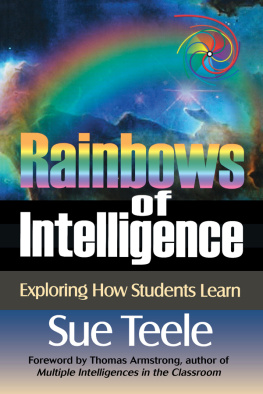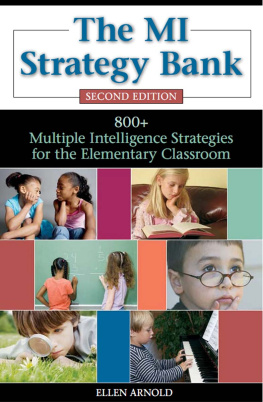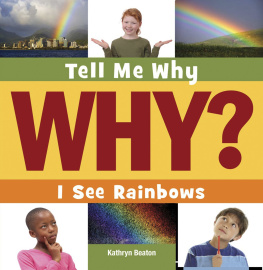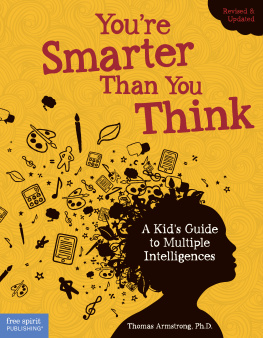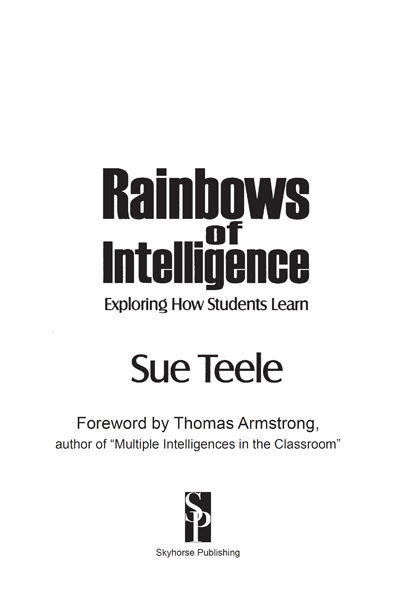Copyright 2000 by Sue Teele
First Skyhorse Publishing edition 2015.
All rights reserved. No part of this book may be reproduced in any manner without the express written consent of the publisher, except in the case of brief excerpts in critical reviews or articles. All inquiries should be addressed to Skyhorse Publishing, 307 West 36th Street, 11th Floor, New York, NY 10018.
Skyhorse Publishing books may be purchased in bulk at special discounts for sales promotion, corporate gifts, fund-raising, or educational purposes. Special editions can also be created to specifications. For details, contact the Special Sales Department, Skyhorse Publishing, 307 West 36th Street, 11th Floor, New York, NY 10018 or info@skyhorsepublishing.com.
Skyhorse and Skyhorse Publishing are registered trademarks of Skyhorse Publishing, Inc., a Delaware corporation.
Visit our website at www.skyhorsepublishing.com.
10 9 8 7 6 5 4 3 2 1
Library of Congress Cataloging-in-Publication Data is available on file.
Cover design by Tracy E. Miller
Print ISBN: 978-1-63220-565-0
Ebook ISBN: 978-1-63220-981-8
Printed in the United States of America
Contents
Part I
Part II
Foreword
T he rainbow is a powerful metaphor for learning and growth. Cross-culturally it symbolizes transformation, the meeting of heaven and earth, the link between the divine and the earthly, and the bridge from one stage of learning to another. In this book, Sue Teele uses it to shed light on the topic of multiple intelligences. Dr. Teele helps educators who are working with multiple intelligences reconcile what appears to be a contradiction within MI theory: How can there be seven distinct intelligences, and yet at the same time, an almost infinite variety of ways that people show their smarts? By using the spectrum of colors to illustrate her point, Teele introduces us to the basic palate of colors we all learned in kindergarten, and shows us how we can combine these colors (translated into seven distinct intelligences) to create a great diversity of hues (an infinite variety of intelligences). Hence, each student, and each curriculum strategy used in the classroom potentially represents a unique blend of the seven primary colors-intelligences.
Rainbows of Intelligence: Exploring How Students Learn provides a wealth of ideas, strategies, resources, and reflections on how to use multiple intelligences to help each student express his or her own personal learning rainbow. Sues personal and engaging style of writing combines her own experiences as an educational researcher, teacher, and grandparent, with some of the latest findings in the field of brain research, cognitive psychology, and human development, to create a work that many teachers will find refreshing and useful to their work in integrating multiple intelligences into the curriculum.
Sues comments on the need for movement in learning, the importance of going beyond phonics in learning to read, and the joy of exploring the richness of connections between math and music, for example, are reflections that badly need to be heard in todays test-driven school system. Her own MI inventory, the Teele Inventory of Multiple Intelligences (TIMI) , speaks volumes in its statistical findings that students identify less and less with linguistic and logical-mathematical images of learning, the more they stay in school. This should send a message to policy makers that the answer to the problem of education today does not lie in piling on the textbook and math problems! Instead, Sue invites us into a world of possibilities with her engaging lesson plans that span the spectrum of multiculturalism, ecology, the life cycle, optics, and many other fascinating subjects.
Truly, this book itself serves as a rainbow, taking readers from the land of theory to the world of practice, in one gliding ride that teachers will find gives them joy and more flexibility in practicing their very important art of education.
T HOMAS A RMSTRONG
Preface
T he ideas for this book have been evolving over the past four years as I have continued to study, research, and apply Howard Gardners theory of multiple intelligences in different educational environments. I have continued the collaboration in my research with two special friends, Jo Gusman and Thomas Armstrong, and I value and respect their talents and expertise. My correspondence over the past four years with Howard Gardner has challenged me to concentrate on discovering ways the educational community can provide greater opportunities for all students to succeed.
I recently had the pleasure of teaching for a week at the new Dream Planet International School in Okinawa, Japan. That experience has deeply influenced my commitment to work diligently in an effort to redesign the educational system to more effectively acknowledge the unique gifts and talents of all individuals. While I was teaching, I witnessed teachers at the school discover and develop their own unique abilities to teach.
The new spatial model I am presenting in this book is designed to build upon multiple intelligences and address the complex pathways that individuals use to process information. The analogy with the rainbows, spectrum, prisms, and colors is very appropriate. When students are provided the opportunity to let their lights shine, they can reveal a full prism of abilities that might never be discovered if they are not allowed to use their full spectrum of intelligences.
I am deeply concerned that in the concentrated effort to improve academic achievement and raise the level of standards for student success, we have ignored the most important ingredient for success, the focus on the uniqueness of each students ability to learn. This book is written in an effort to emphasize the need to explore how students learn and to consider that domain during all the discussions of academic standards and methods for assessing students.
Many individuals have assisted me in creating this book. First, I want to thank my family, who have supported me during the research and writing. My husband, Steve, has been my number one supporter, and I am very grateful that he has always believed in my abilities. My two sons, Brett and Chris, have been very much a part of my motivation to improve the quality of education and both have been instrumental in my being able to develop my ideas for the future. My two daughters-in-law have immediately been brought into the multiple intelligences world and have contributed in many ways to this book. My seven grandchildren have provided a living laboratory for me to study how children develop in their progressions of learning. My mom has always been interested in learning about my research and what makes her dendrites continue to branch. My staff at the University of California, Riverside, has assisted me in creating some of the ideas in this book.
I began to think about this book 2 years ago and it seems that every opportunity I have been given has had a direct influence on the evolution of this book. Part I was designed to present current research findings and establish a rationale for the spatial model I have presented. The units in Part II will demonstrate for teachers how to develop lessons that integrate the intelligences, offer multiple measures of assessment, and provide methods for incorporating content standards into each lesson.
This book was created to acknowledge that all individuals have their own unique rainbows of intelligence and, given the proper opportunities to shine, they will demonstrate academic achievement by applying their full spectrum of human potential. We must work together to ensure that all students are given the opportunity to achieve success.

